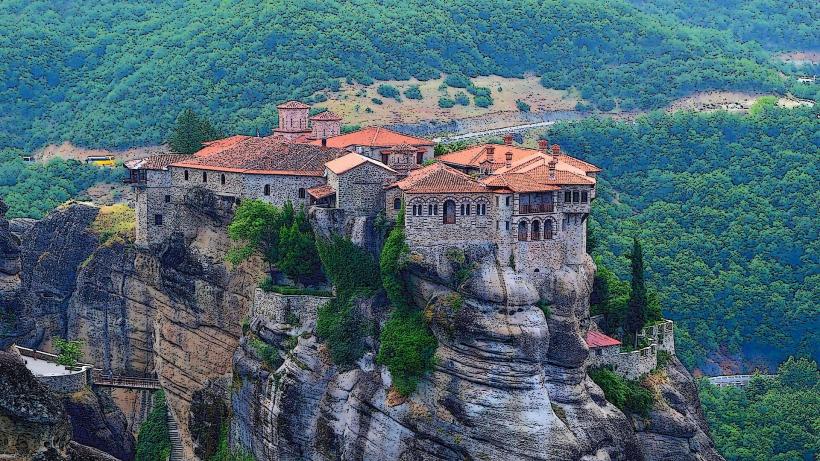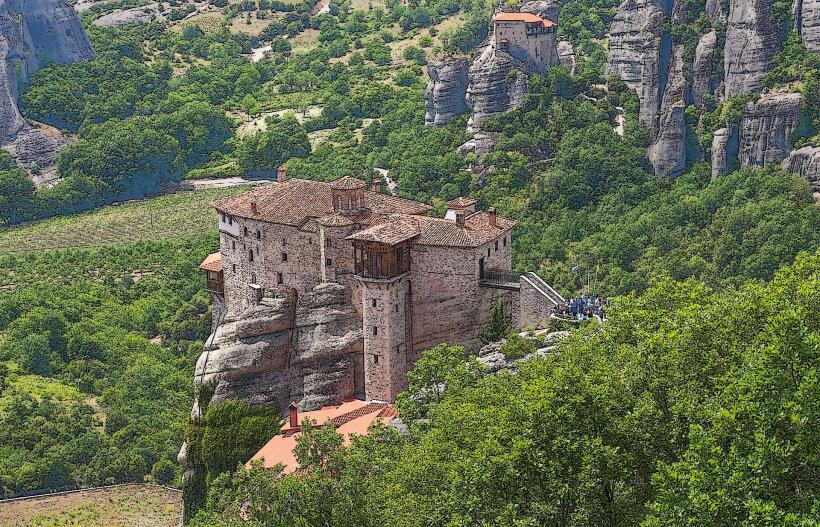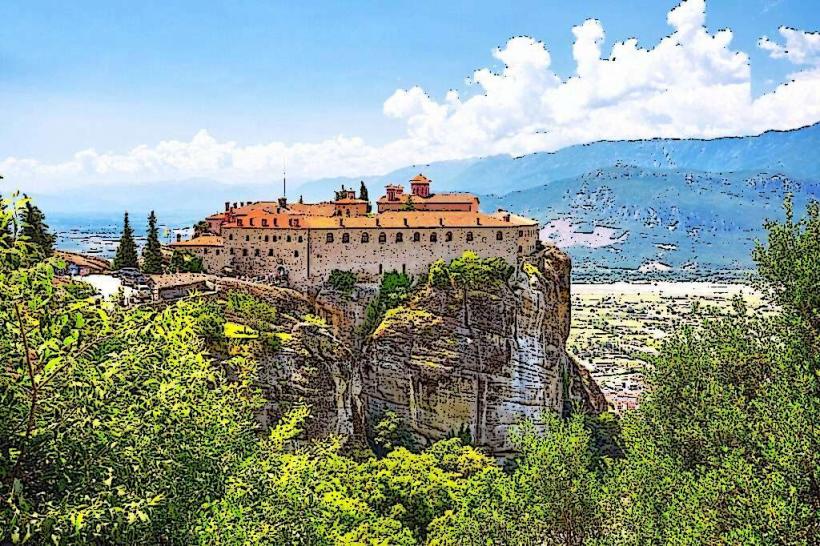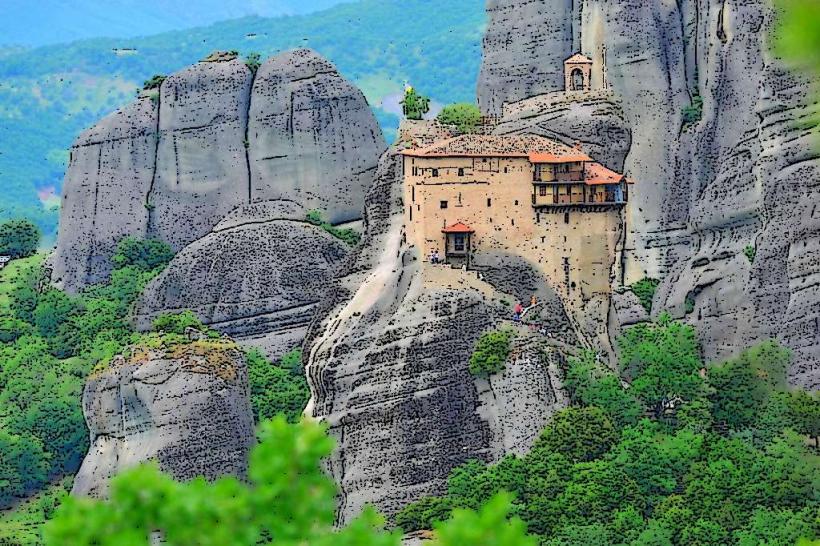Information
Landmark: Great Meteoron MonasteryCity: Meteora
Country: Greece
Continent: Europe
The Great Meteoron Monastery (Greek: Μονή Μεγάλου Μετεώρου) is the largest and oldest of the monasteries in the Meteora complex, a UNESCO World Heritage site in central Greece. The monastery is perched on top of one of the dramatic rock pillars that give Meteora its distinctive landscape. This monastic complex, founded in the 14th century, has played a significant role in Greek Orthodox monasticism and remains an important cultural and religious center.
1. Historical Background
- Foundation and Early History: The exact date of the founding of Great Meteoron is not entirely clear, but it is believed to have been established in 1344 by Saint Athanasios the Meteorite, a monk from Mount Athos. Saint Athanasios, often considered the first founder of Meteora's monastic movement, sought a remote location for asceticism and spiritual practices, and the towering rock pillars of Meteora provided the perfect environment for such an endeavor. Initially, a small hermitage was established at the site, and over time, it evolved into the largest and most influential monastery in the region.
- Development Over Time: In the centuries that followed, Great Meteoron became the most prosperous monastery in Meteora, especially during the 16th century when it attracted numerous monks and became a center of spiritual and scholarly activity. At its peak, the monastery housed a significant number of monks and operated a school, becoming an influential religious and cultural institution.
2. Architecture and Layout
The architecture of the Great Meteoron Monastery is a blend of Byzantine and post-Byzantine styles, characterized by its modest yet impressive design, which fits harmoniously with the natural landscape of the Meteora rocks.
Location and Accessibility: The monastery is situated at a height of about 613 meters (2,011 feet) above sea level, atop one of the towering Meteora rock formations. The natural setting offers stunning views of the surrounding plains, valleys, and other rock formations. Access to the monastery, in the past, was extremely difficult, requiring monks to climb the rocks or be lifted up in a basket. Today, a road leads to the monastery, making it more accessible to visitors.
Monastery Complex: The monastery complex includes several buildings:
- Church of the Transfiguration: The main church (or katholikon) of the monastery is dedicated to the Transfiguration of Christ. It is a beautiful example of Byzantine-style ecclesiastical architecture, with a large central dome and intricate interior decorations.
- Cells and Rooms: Surrounding the central church are the monks' cells and other buildings, such as a refectory (dining hall), a library, and workshops, which were used for various practical purposes. The cells are simple but functional, built into the natural rock.
- Iconography and Frescoes: The monastery is famous for its stunning frescoes, many of which were painted by Georgios Kalliergis, one of the leading iconographers of the 16th century. These frescoes cover the walls and ceilings of the church and depict scenes from the Bible, saints, and the life of Christ. The iconostasis (the wooden screen separating the altar from the nave) is adorned with richly painted icons that are important examples of post-Byzantine religious art.
- Museum: The monastery houses a small museum showcasing religious artifacts, manuscripts, liturgical items, and historical objects that trace the history and spiritual life of the monastery. Many of these artifacts are centuries old and provide a glimpse into the daily life and religious practices of the monks.
Defensive Features: Given the location of the monastery, it was naturally well-defended against potential invaders. The fortified walls and watchtowers were an important part of its architecture, adding to the monastery's strategic advantage during times of war or unrest.
3. Role in Greek Orthodoxy and History
Monastic Community: The Great Meteoron Monastery was once home to many monks, and it served as a spiritual center for the Orthodox Christian community. It played a crucial role in preserving Greek Orthodox traditions and practices, especially during times of foreign rule and invasion. The monastery was a beacon of spirituality, learning, and religious life, particularly in the Ottoman era, when many monasteries in Greece were centers of resistance to foreign oppression.
Cultural and Educational Center: During the height of its influence, the monastery was not only a religious center but also a hub for education and scholarship. The monks of Great Meteoron, like those of other Meteora monasteries, were involved in copying manuscripts, preserving religious texts, and providing education to the local population.
Role During Ottoman Occupation: Like the other Meteora monasteries, the Great Meteoron played an important role during the Ottoman occupation of Greece. In times of crisis, it offered refuge to persecuted Greeks and became a symbol of Greek identity and resistance. The monks also helped protect Greek Orthodox communities in the area and contributed to the Greek War of Independence in the 19th century.
4. Decline and Revival
Decline: In the 18th and 19th centuries, the number of monks at Great Meteoron, like other monasteries in Meteora, began to decline due to various factors, including economic hardships, the changing political landscape under Ottoman rule, and the rise of secularism. By the early 20th century, the monastery had been largely abandoned, and its buildings fell into disrepair.
Revival: In the 20th century, the Great Meteoron Monastery, like the other Meteora monasteries, experienced a revival with the establishment of the Greek State and the efforts of the Greek Orthodox Church to restore the monasteries. Today, the monastery is an active religious site, though its monastic community is much smaller than it was in the past. The monastery is still used for prayer and religious services, and it is open to visitors, attracting thousands of pilgrims and tourists each year.
5. Visitor Experience
Access and Views: Visitors can access the Great Meteoron Monastery by a road that leads up the mountain, making it accessible for tourists and pilgrims. The monastery offers panoramic views of the surrounding Meteora rock formations and the Thessalian Plain below. The view from the monastery is breathtaking and provides a sense of the dramatic and awe-inspiring landscape of Meteora.
Monastery Grounds: Visitors to the monastery can explore the main church, the cells, the museum, and the courtyards. The peaceful atmosphere of the monastery, combined with its stunning architecture and scenic location, makes it a memorable place for reflection and contemplation.
Frescoes and Icons: One of the highlights of a visit to the monastery is the opportunity to admire the frescoes and icons that decorate the church and other parts of the monastery. These works of art are important examples of post-Byzantine religious art and provide insight into the spiritual and cultural life of the monastic community.
6. Cultural and Religious Importance Today
UNESCO World Heritage Site: The Meteora monasteries, including the Great Meteoron, are designated as a UNESCO World Heritage site due to their historical, cultural, and architectural significance. The monastery remains a major attraction for visitors to Greece and is considered one of the most important monastic sites in the Orthodox Christian world.
Active Religious Site: Despite its status as a tourist destination, the Great Meteoron Monastery remains an active religious site, with services still being held in the church. It continues to serve as a place of worship and spiritual retreat for those who seek the tranquility of the monastic life.
Conclusion
The Great Meteoron Monastery is a stunning and historically significant structure that offers visitors a glimpse into the spiritual and architectural grandeur of the Meteora region. With its rich history, breathtaking location, and impressive architectural features, it remains one of the most important monasteries in Greece. Its enduring legacy as a center of Orthodox Christianity, education, and cultural preservation continues to make it a symbol of religious devotion and artistic achievement.






